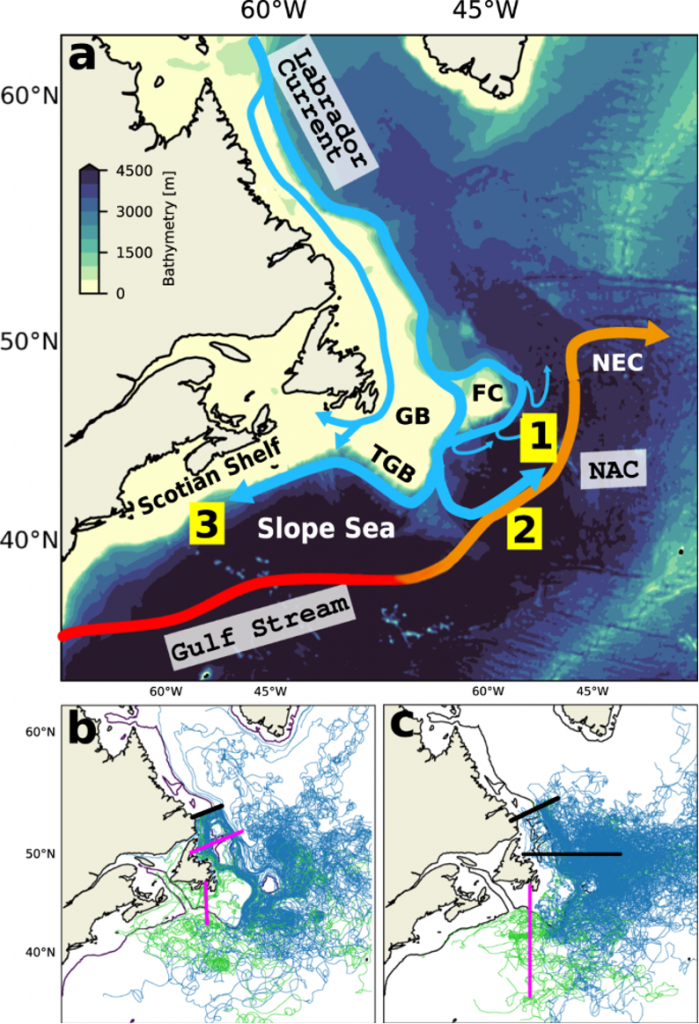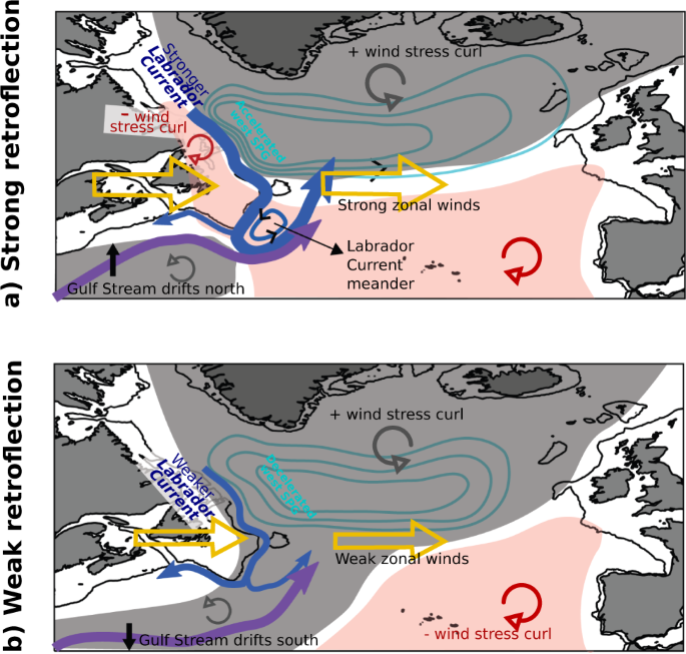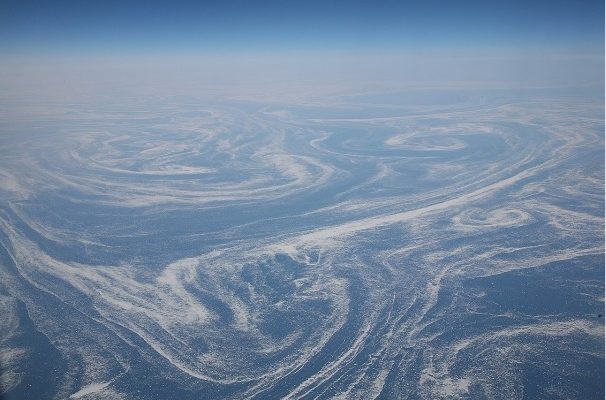In the north-west Atlantic, the Labrador Sea, nestling between the coasts of Greenland and Canada, is traversed by a mass of cold, oxygen-rich water from the Arctic Ocean, known as the Labrador Current. Since 2008, a deviation of this current from its usual course had already been identified, with in particular the observation of a warming, a decrease in dissolved oxygen and an acidification of the deep waters of the St. Lawrence estuary. In a new study, scientists from McGill University have finally shed light on the factors responsible for this deviation, revealing a complex system in which the wind plays a predominant role.
by Laurie Henry
OCEAN CURRENTS, THE KEY TO CLIMATE
Ocean currents play an essential role in regulating the world’s climate. By acting as real conveyors of warm or cold water through the oceans, they influence regional temperatures, weather conditions and aquatic ecosystems.
Ocean currents drive global ocean circulation, redistributing heat from the equator to the poles and from the surface to the deepest depths – and vice versa. This global ocean circulation thus contributes to the balance of our planet’s climate, but also to that of marine biodiversity, since thanks to these marine currents, nutrients circulate from the depths to the surface, feeding marine life in areas that would otherwise be unproductive.

The trajectory of the Labrador Current. The figures indicate the main paths of the Labrador Current in the Grand Banks region, as revealed by the trajectories of the virtual particles: (1) deflected eastwards between the Flemish Cap and the tip of the Grand Banks, (2) deflected eastwards at the southern tip of the Grand Banks, and (3) following a westward route along the break in the continental shelf. (1) and (2) represent two retroflection paths. The following topographic features are indicated: Grands Bancs (GB), pointe des Grands Bancs (TGB) and Bonnet Flamand (FC). NEC refers to the north-east corner. © M. Jutras et al., 2023
Within the Labrador Sea, the Labrador Current stands out for its crucial influence on the waters of the Northwest Atlantic. Originating in the Arctic Ocean, this cold, oxygen-rich current flows southwards along the coast of Newfoundland and Labrador, before splitting into multiple branches along the Canadian and American coasts.
Scientists have already confirmed the trajectory of the Labrador Current, which is constantly pushed by the Gulf Stream, the surface current that flows from Mexico towards Europe in the North Atlantic, forcing it eastwards. This is how the Labrador Current usually enters the St Lawrence estuary, feeding it with cold, oxygenated, nutrient-rich water.
THE WINDS, REGULATORS OF THE LABRADOR CURRENT
Recently, however, measurements taken on the waters of the St Lawrence estuary have shown a warming, oxygen depletion and progressive acidification of these waters, which are normally cooled and fed by the Labrador Current.
A recent study, published in Nature Communications and conducted by McGill University, could provide an explanation for this phenomenon. It highlights the mechanisms at work in the recently observed change in the usual trajectory of the Labrador Current, which could explain its movement away from the waters of the St Lawrence estuary.
Using sophisticated simulation models, the researchers simulated the movement of water particles within the Labrador Current, from their departure in the Arctic and all the way along the Canadian and American coasts. The results reveal the substantial impact of variations in wind patterns on the direction and strength of the Labrador Current as it moves southwards. When winds become stronger, they tend to push the Labrador Current eastwards, diverting it from its usual route and preventing it from entering the St Lawrence estuary.

Changes in the Labrador Current. © M. Jutras et al., 2023
The interaction between the Labrador Current and the Gulf Stream amplifies the effects of this redirection. The Gulf Stream, which transports warm waters from the Gulf of Mexico to the North Atlantic, is also influenced by the same wind patterns. When these winds push the Gulf Stream closer to the coast, they also facilitate the northward movement of this warm current, which can reduce the space available for the Labrador Current along the coast and encourage its eastward deviation.
Mathilde Jutras, an oceanography researcher and co-author of a study published in June 2023 in the journal Nature Communications. “Thanks to our research, we have found that the two currents are in fact responding to a broader circulation pattern.”
This dynamic between warm and cold currents is fundamental to understanding climatic and ecological variations in the North Atlantic. The increased proximity of the Gulf Stream can modify coastal climatic conditions, increasing temperatures and modifying precipitation.
TOWARDS A GLOBAL UNDERSTANDING OF MARINE CURRENTS FOR BIODIVERSITY
These discoveries open up important prospects for the management of marine resources and the conservation of ocean ecosystems. By identifying the key factors influencing the trajectory of the Labrador Current, scientists will be able to better anticipate future variations and their potential impact on marine biodiversity. This knowledge is essential for developing adaptive strategies in the face of current and future ecological changes.
The redirection of the Labrador Current as a result of strong winds is profoundly altering the ecological and economic balance of the Atlantic regions. Mathilde Jutras, a doctoral student in the Department of Earth and Planetary Sciences at McGill University, explains in a press release: “We end up with less dissolved oxygen in the water, which means that species have to expend more energy to breathe, leaving them less energy to feed or subsist. The growth of species such as cod or halibut slows down as oxygen levels fall”. She adds: “This also leads to the migration of living creatures, as they generally try to avoid hypoxic areas, i.e. areas with lower oxygen levels”.
From an economic point of view, these ecological changes have a direct impact on coastal communities dependent on fishing. Changes to marine habitats can lead to a reduction in fish stocks, affecting catches and, consequently, fishermen’s incomes. In addition, the deflection of the Labrador Current also influences the climate and weather conditions in these regions, with potential repercussions for agriculture and tourism. Ultimately, the complex interaction between wind patterns and ocean currents highlights the importance of monitoring and understanding atmospheric and oceanic dynamics in order to anticipate and mitigate their effects on the environment and the economy.
